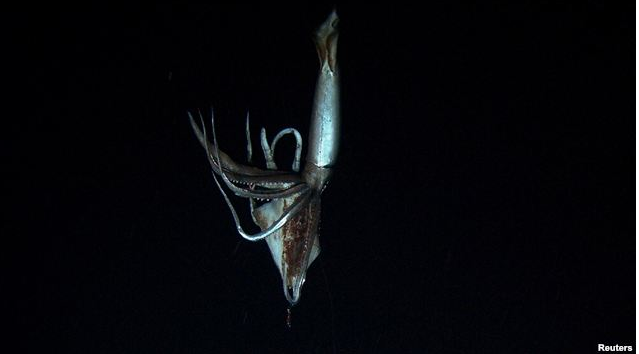
A giant squid is seen in this still image taken from video captured from a submersible by a Japanese-led team of scientists near Ogasawara islands taken in July 2012, in this handout picture released by NHK/NEP/Discovery Channel in Tokyo January 7, 2013.
Reuters -Â A Japanese-led team of scientists has captured on film the world’s first live images of a giant squid, journeying to the depths of the ocean in search of the mysterious creature thought to have inspired the myth of the `”kraken”, a tentacled monster.
Though the beast was small by giant squid standards – the largest ever caught stretched 18 meters long, tentacles and all – filming it secretly in its natural habitat was a key step towards understanding the animal, researchers said.
“Many people have tried to capture an image of a giant squid alive in its natural habitat, whether researchers or film crews. But they all failed,” said Tsunemi Kubodera, a zoologist at Japan’s National Museum of Nature and Science, who led the team.
“These are the first-ever images of a real live giant squid,” Kubodera said of the footage, shot by Japanese national broadcaster NHK and the Discovery Channel.
The key to their success, said Kubodera, was a small submersible rigged with lights invisible to both human and cephalopod eyes.
He, a cameraman and the submersible’s pilot drifted silently down to 630 meters and released a one-meter-long squid as bait. In all, they descended around 100 times.
“If you try and approach making a load of noise, using a bright white light, then the squid won’t come anywhere near you. That was our basic thinking,” Kubodera said.
“So we sat there in the pitch black, using a near-infrared light invisible even to the human eye, waiting for the giant squid to approach,” he said.
As the squid neared they began to film, following it into the depths to around 900 meters.
“I’ve seen a lot of giant squid specimens in my time, but mainly those hauled out of the ocean. This was the first time for me to see with my own eyes a giant squid swimming,” he said. “It was stunning, I couldn’t have dreamt that it would be so beautiful. It was such a wonderful creature.”
Until recently, little was known about the creature believed to be the real face of the mythical kraken, a sea-monster blamed by sailors for sinking ships off Norway in the 18th century.
But for Kubodera, the animal held no such terror.
“A giant squid essentially lives a solitary existence, swimming about all alone in the deep sea. It doesn’t live in a group,” he said. “So when I saw it, well, it looked to me like it was rather lonely.”
